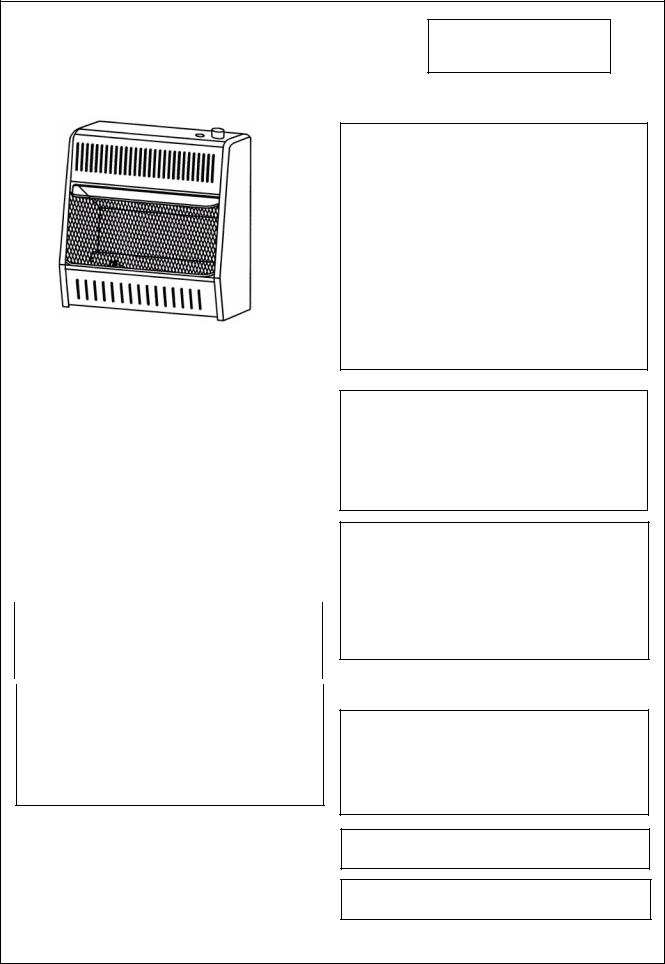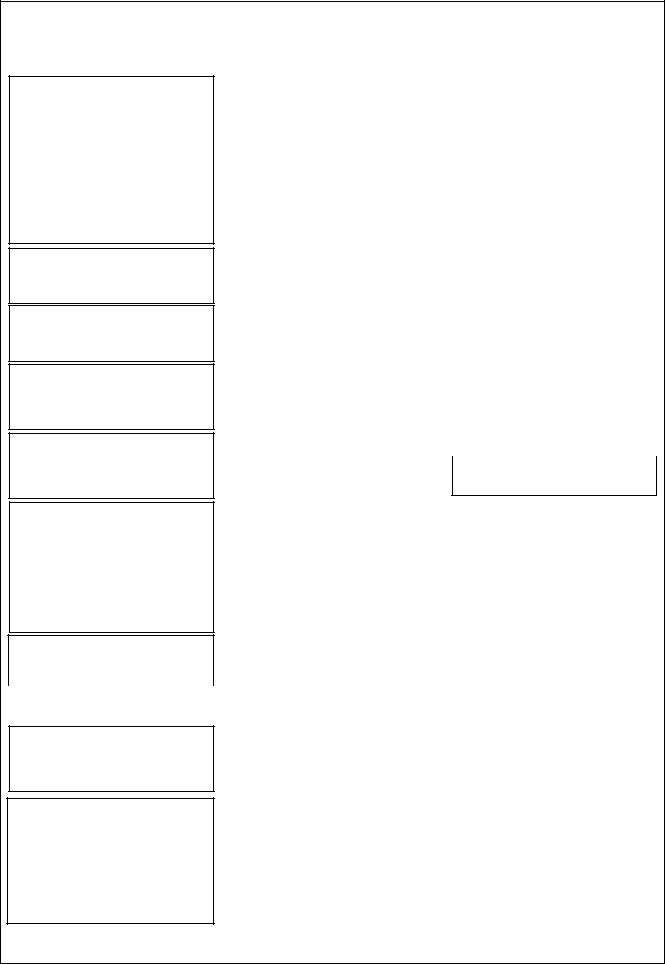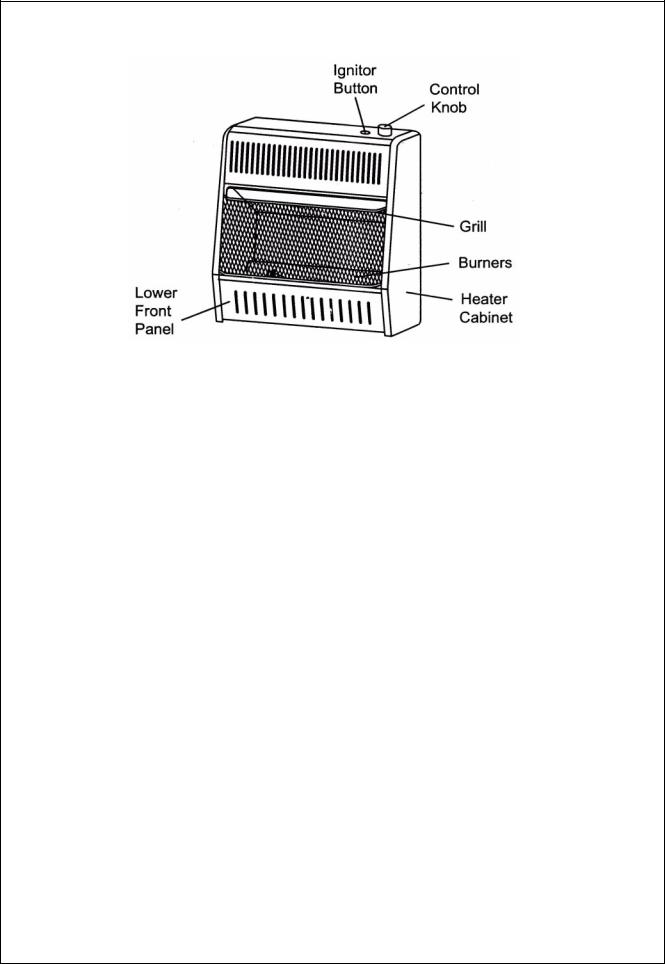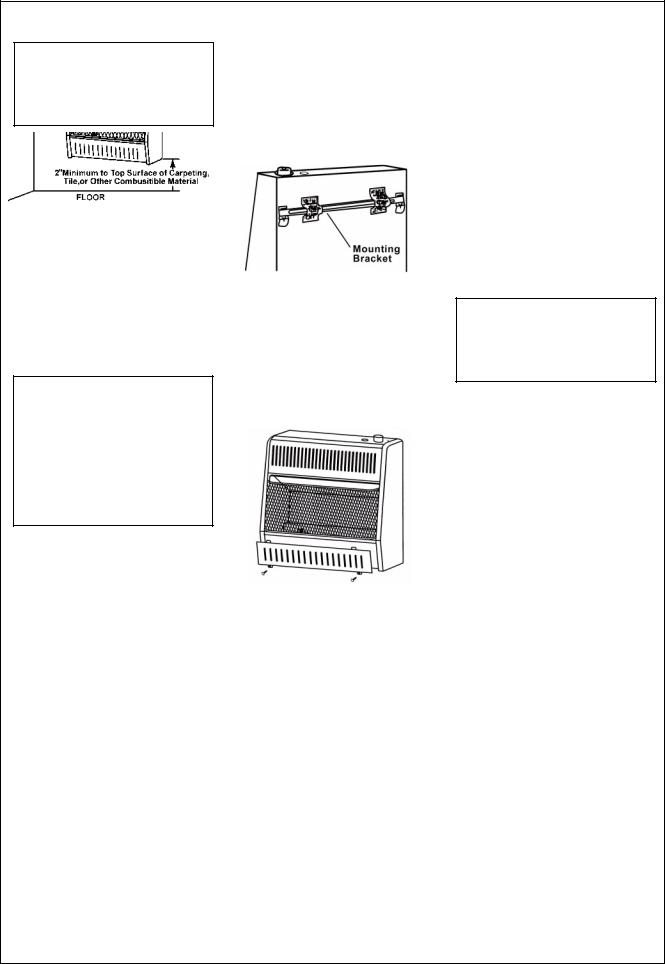Procom ML300TBA, ML300HBA, ML200TBA, ML200HBA User Manual

BLUE FLAME VENT-FREE
PROPANE/LP GAS
SPACE HEATER
OWNER’S OPERATION AND INSTALLATION MANUAL
ML200HBA ML200TBA
ML300HBA ML300TBA
Table of Contents
Important Safety Information................................. |
|
2 |
||
Product Features..................................................... |
|
|
3 |
|
Proper Ventilation & Fresh Air............................... |
4 |
|||
Installation................................................................ |
|
|
|
6 |
Operating Your Heater........................................... |
|
|
10 |
|
Cleaning & Maintenance....................................... |
|
13 |
||
Trouble Shooting................................................... |
|
|
14 |
|
Specifications.......................................................... |
|
|
17 |
|
Parts List................................................................. |
|
|
|
19 |
|
|
|
|
|
WARNING: If |
the |
information |
in this |
|
manual is |
not followed |
exactly, a |
f i r e o r |
|
e x p l o s i o n |
m a y |
r e s u l t causing property |
||
|
damage, personal injury, |
or |
loss of |
life. |
|
|
|
|
|
|
|
|
WARNING: This is |
an |
unvented gas-fired |
||
|
heater. It uses |
air (oxygen) f r o m |
t h e r o o m |
||
|
i n w h i c h i t |
i s installed. Provisions for |
|||
adequate combustion and ventilation air must
be |
provided . Refer to Air For Combus- |
tion |
and Ventilation section on page 4 of this |
manual.
Continental Appliance Inc.
5 Musick, Irvine
California, 92618
TOLL-FREE PHONE NUMBER: (877)886-5989
Do not store, or use gasoline or other flammable vapors and liquids in the vicinity of this or any other appliance.
WHAT TO DO IF YOU SMELL GAS
|
Do |
not try to light any appliance. |
||
|
Do |
not |
touch |
any electrical switch; do not |
|
use |
any |
phone |
in your building. |
Immediately call your gas supplier from a neighbor’s phone. Follow the gas supplier’s
instructions.
If |
you |
cannot reach your gas supplier, call |
the |
fire |
department. |
Installation and service must be performed by a qualified installer, service agency or gas supplier.
 WA R N I N G : Improper installation, adjustment, alteration, service or maintenance can cause injury or property damage. Refer to this manual for correct installation and operational procedures. For assistance or additional information consult a qualified installer, service agency, or gas supplier.
WA R N I N G : Improper installation, adjustment, alteration, service or maintenance can cause injury or property damage. Refer to this manual for correct installation and operational procedures. For assistance or additional information consult a qualified installer, service agency, or gas supplier.
This appliance may be installed in an aftermarket* permanently located, manufactured (mobile) home, where not prohibited by local codes.
This appliance is only for use with the type of gas indicated on the rating plate. This appliance is not convertible for use with other gases.
*Aftermarket: Completion of sale, not for purpose of resale, from the manufacturer.
WATER VAPOR: A BY-PRODUCT OF UNVENTED ROOM HEATERS
Water vapor is a by-product of gas combustion. An unvented room heater produces approximately one
(1) ounce (30ml) of water for every 1,000 BTU’s (3KW’s) of gas input per hour. Refer to page 3.
Installer: Please leave these instructions with the consumer.
Consumer: Please retain these instructions for future use.

IMPORTANT
SAFETY INFORMATION
WARNINGS
I M P O R TA N T: Read this
owner’s manual carefully and completely before trying to assemble, operate, or service this heater. Improper use of this heater can cause serious
injury |
or death from burns, |
|
f i r e , |
e x p l o s i o n , |
e l e c t r i c a l |
shock, |
and carbon |
monoxide |
poisoning.
 WARNING: Do not use any accessory not approved for use with this heater.
WARNING: Do not use any accessory not approved for use with this heater.
 WARNING: Any change to this heater or its controls can be dangerous.
WARNING: Any change to this heater or its controls can be dangerous.
Do not place clothing or other flammable material on or near the appliance. Never place any objects on the heater.
Due to high temperatures, heater s h o u l d b e k e p t o u t o f traffic and away from furniture and draperies.
Surface of heater becomes very hot when running heater. Keep children and adults away from hot surface to avoid burns or clothing ignition. Heater will remain hot for a time after shuting down. Allow surface to cool before touching.
C a r e f u l l y s u p e r v i s e y o u n g children when they are in the
same |
room with heater. |
|
|
Make |
sure grill guard is in |
place |
before running the heater. |
|
|
Keep the appliance area clear and free from combustible materials, gasoline, and other flammable vapors and liquids.
State of Massachusetts: The installation must be made by a licensed plumber or gas fitter in the Commonwealth of Massachusetts.
Sellers of unvented propane or natural gas-fired supplemental room heaters shall provide to each purchaser a
|
9. |
Turn |
off heater |
before using |
|||||||||||||
copy of 527 CMR 30 upon sale of the |
|||||||||||||||||
unit. |
|
|
|
|
|
|
|
|
furniture polish, |
wax, carpet |
|||||||
|
|
|
|
|
|
|
|
cleaner, or |
similar products. If |
||||||||
|
|
|
|
|
|
|
|
|
|
||||||||
In the state of Massachusetts, unvented |
|
|
heated, the vapors from these |
||||||||||||||
propane or nature gas-fired space heat- |
|
|
products may create a white |
||||||||||||||
ers shall be prohibited in bedrooms and |
|
|
powder |
residue |
within burner |
||||||||||||
bathrooms. |
|
|
|
|
|
box |
or |
on adjacent |
walls |
or |
|||||||
|
|
|
|
|
furniture. |
|
|
|
|
||||||||
|
|
|
|
|
|
|
|
|
|
|
|
|
|
||||
|
|
|
|
|
|
|
|
|
|
|
|
|
|
||||
|
|
|
|
|
|
|
|
10. Do not use heater if any part |
|||||||||
1. |
This |
|
appliance |
is |
only for use |
|
|
has |
been |
under |
water. |
||||||
|
with |
|
the type of |
gas indicated |
|
|
Immediately call |
a qualified |
|||||||||
|
on the rating plate. This |
|
|
service |
technician |
to inspect |
|||||||||||
|
appliance is not convertible for |
|
|
the room heater and to |
|
||||||||||||
|
use |
with other |
gases. |
|
|
replace any part of the control |
|||||||||||
2. |
Do |
|
not |
place |
propane/LP |
|
|
system and any gas control |
|||||||||
|
supply |
tank(s) |
inside any |
|
|
which has been under water. |
|||||||||||
|
structure. Locate |
propane/LP |
11. Turn off heater and let cool |
||||||||||||||
|
supply |
tank(s) |
outside. |
|
|
before |
servicing. Only a |
|
|||||||||
3. |
If you |
smell |
gas |
|
|
|
qualified service |
person |
should |
||||||||
|
Shut |
off |
gas |
supply. |
|
|
|||||||||||
|
|
|
service and |
repair heater. |
|
||||||||||||
|
Do |
not |
try to |
light |
any appliance. |
|
|
|
|||||||||
12. |
Operating heater above |
|
|||||||||||||||
|
Do |
not |
touch |
any |
electrical switch; |
|
|||||||||||
|
|
elevations |
of 4,500 feet |
could |
|||||||||||||
|
do not use any phone in your |
|
|
||||||||||||||
|
|
|
cause pilot |
outage. |
|
|
|||||||||||
|
building. |
|
|
|
|
|
|
|
|||||||||
|
|
|
|
13. To prevent performance, problems, |
|||||||||||||
|
Immediately call |
your gas supplier |
|||||||||||||||
|
|
do not use propane/LP fuel tank of |
|||||||||||||||
|
from a neighbor’s |
phone. Follow |
|
|
|||||||||||||
|
|
|
less |
than 100 lbs. capacity. |
|||||||||||||
|
the |
|
gas supplier’s instructions. |
|
|
||||||||||||
|
|
|
|
|
|
|
|
|
|
|
|||||||
If you cannot reach your gas |
|
|
|
||||||||||||||
|
|
DANGER: Carbon monoxide |
|||||||||||||||
|
supplier, call |
the |
fire department. |
|
poisoning may lead to death ! |
||||||||||||
4.This heater shall not be
installed in a bathroom or Carbon Monoxide Poisoning:
|
bedroom. |
|
|
|
|
|
|
Early signs of carbon monoxide |
||||||||
5. |
This heater needs fresh, |
|
poisoning resemble the flu with |
|||||||||||||
|
outside air ventilation to run |
headaches, dizziness, or |
nausea. |
|||||||||||||
|
properly. This heater has an |
If you have |
these signs, the |
heater |
||||||||||||
|
Oxygen Depletion Sensor |
|
may |
not be |
working |
properly. Get |
||||||||||
|
(ODS) safety shutoff |
system. |
fresh |
air at once! Have |
|
heater |
||||||||||
|
The ODS shuts down the |
|
|
|||||||||||||
|
|
serviced. Some people are more af- |
||||||||||||||
|
heater if not |
enough |
|
fresh |
air |
|||||||||||
|
|
fected by carbon monoxide |
than |
|||||||||||||
|
is available. See |
Fresh Air |
for |
|||||||||||||
|
others. These |
include pregnant |
||||||||||||||
|
Combustion and |
Ventilation |
|
|||||||||||||
|
|
women, persons |
with heart |
or |
lung |
|||||||||||
|
pages 4 and 5. |
|
|
|
|
|||||||||||
|
|
|
|
|
disease or anemia, those under |
the |
||||||||||
6. |
Keep all air |
openings |
|
in front |
||||||||||||
|
influence of |
alcohol, |
and |
those |
||||||||||||
|
and |
at the bottom |
of |
heater clear |
||||||||||||
|
at high altitudes. |
|
|
|
|
|
||||||||||
|
and |
free of debris. This will |
|
|
|
|
|
|||||||||
|
Propane/LP Gas: Propane/LP gas |
|||||||||||||||
|
insure enough air for |
proper |
||||||||||||||
|
is odorless. An odor-making agent |
|||||||||||||||
|
combustion. |
|
|
|
|
|
||||||||||
|
|
|
|
|
|
is added to Propane/LP gas. The |
||||||||||
7. |
If heater shuts |
off. Do |
|
not |
|
|||||||||||
|
|
odor helps you detect a Propane/LP |
||||||||||||||
|
relight until you |
provide |
fresh |
|
||||||||||||
|
|
gas leak. However, the odor added to |
||||||||||||||
|
outside air. If |
heater keeps |
|
|||||||||||||
|
|
Propane/LP gas can fade. Propane/ |
||||||||||||||
|
shutting off, have it serviced. |
|
||||||||||||||
8. |
Do not operate heater |
|
LP gas may be present even though |
|||||||||||||
|
where flammable liquids or vapors |
no odor exists. |
|
|
|
|
|
|||||||||
|
are used or |
stored |
|
|
|
|
Make certain you read and under- |
|||||||||
|
under |
dusty |
conditions |
|
|
|
stand all warnings. Keep this manual |
|||||||||
|
|
|
|
|
|
|
|
|
for reference. It is your guide to safe |
|||||||
|
|
|
|
|
|
|
|
|
and proper operation of |
this |
|
heater. |
||||
2

PRODUCT FEATURES
Figure1-Vent-Free Propane/LP Gas Heater
SAFETY DEVICE
A standard requirement for all vent-free room heaters. This heater has a pilot with an Oxygen Depletion Sensor(ODS) safety shutoff system. The ODS/pilot shuts off the heater if there is not enough fresh air.
PIEZO IGNITION SYSTEM
This heater is equipped with a piezo ignitor. This system requires no matches, batteries, or other sources to light heater.
THERMOSTATIC HEAT CONTROL ON THERMOSTAT MODELS
These heaters have a control valve with a thermostat sensing bulb. This results in the greatest heater comfort and may result in lower gas bills.
LOCAL CODES
Install and use heater with care. Follow all local codes. In the absence of local codes, use the latest edition of National Fuel Gas code ANSZ223.1, also known as NFPA 54*.
*Available from :
American National Standards Institute, Inc. 1430 Broadway
New York, NY 10018 National Fire Protection Association, Inc.
Batterymarch Park
Quincy, MA 02269
UNPACKING
1.Remove heater from carton.
2.Remove all protective packaging applied to
heater for shipment.
3. Check heater for any shipping damage. If heater is damaged, promptly inform dealer where you bought heater.
WATER VAPOR: A BYPRODUC T O F U NV E N T E D R O O M H EAT ER S
Water vapor is a by-product of gas combustion. An unvented room heater produces approximately one
(1) ounce (30ml) of water for every 1,000 BTU’s (3KW’s) of gas input per hour.
Unvented room heaters are recommended as supplemental heat (a room) rather than a primary heat source (an entire house). In most supplemental heat applications, the water vapor does not create a problem. In most applications, the water vapor enhances the low humidity atmosphere experienced during cold weather.
The following steps will help insure that water vapor does not become a problem.
1.Be sure the heater is sized properly for the application, including ample combustion air and circulation air.
2.If high humidity is experienced, a dehumidifier may be used to help lower the water vapor content of the air.
3.Do not use an unvented room heater as the primary heat source.
3

FRESH AIR FOR
COMBUSTION AND
VENTILATION
 WARNING: This heater shall not be installed in a
WARNING: This heater shall not be installed in a
confined space |
or |
unusually |
||
tight construction |
unless |
|||
provisions |
are |
provided |
for |
|
adequate |
combustion |
and |
||
ventilation |
air . |
Read |
the |
|
f o l l o w i n g |
i n s t r u c t i o n s |
t o |
||
insure proper fresh air for this and other fuel-burning appliances in your home.
PROVIDING ADEQUATE VENTILATION
The following are excerpts from
National Fuel Gas Code. NFPA 54/ ANS Z223.1, Section 5.3. Air for Combustion and Ventilation. All spaces in homes fall into one of the three following ventilation classifications:
1.Unusually Tight Construction
2.Unconfined Space
3.Confined Space
The information on pages 4 through 6 will help you classify your space and provide adequate ventilation.
Unusually Tight Construction
The air that leaks around doors and windows may provide enough fresh air for combustion and ventilation. However, in buildings of unusually tight construction, you must provide additional fresh air.
Unusually tight construction is defined as construction where: a. walls and ceilings exposed to the outside atmosphere have a continuous water vapor retarder with a rating of one per m (6×10-11 kg per pa-sec-m2) or less with openings gasketed or sealed and
b.weather stripping has been added on openable windows and doors and
c.caulking or sealants are applied to areas such as joints around window and door frames, between sole plates and floors, between wall-ceiling joints, between wall panels, at penetrations for plumbing, electrical, and gas lines, and at other openings. If your home meets all of the three criteria above, you must provide additional fresh air.
See Ventilation Air from Outdoors, page 6. If your home does not meet all of the three criteria above see Determining Fresh-Air Flow for Heater Location, page 5.
Confined and
Unconfined Space
The National Fuel Gas Code ANS
Z223.1 defines a confined |
space |
as a space whose volume |
is less |
than 50 cubic feet per 1,000 |
Btu per |
hour (4 .8 m 3 per kw) of the aggregate input rating of all appliances installed in that space and an unconfined space as a space whose volume is not less than 50 cubic feet per 1,000 Btu per hour (4.8 m3 per kw) of the aggregate input rating of all appliances installed in that space. Rooms communicating directly with
t h e s p a c e |
i n w h i c h t h e |
appliances are |
installed*, through |
openings not furnished with doors, are considered a part of the unconfined space.
This heater shall not be installed in a confined space or unusually tight construction unless provisions are provided for adequate combustion and ventilation air.
* Adjoining rooms are communicating only if there are doorless passageways or ventilation grills between them.
DETERMINING FRESH-AIR FLOW FOR HEATER LOCATION
Determining if you have a Confined or Unconfined Space* |
|
|
||||||||||
Use this worksheet to determine if you have a confined or unconfined space. |
|
|||||||||||
Space: Includes the room in which you will install heater plus any |
adjoining rooms with doorless |
passageways |
||||||||||
or ventilation |
grills |
between |
the rooms. |
|
× |
|
|
|
|
|||
1. |
Determine |
the |
volume of |
× |
width |
height). |
|
|
|
|||
the space (length |
|
|
|
|
||||||||
|
Length×Width×Height= |
|
|
cu.ft. (volume of space) |
|
|
|
|||||
|
Example: Space size20ft. (length)×16ft. ( width)×8ft. (ceiling |
height)=2560cu. ft. (volume of space) |
|
|||||||||
|
If additional ventilation to adjoining room is |
supplied with |
grills |
or openings, add the volume |
of these |
|||||||
|
rooms to the total volume of the space. |
|
|
|
|
|
|
|||||
2. |
Divide the space volume by 50 cubic feet to determine the maximum Btu/Hr the space can support. |
|||||||||||
(volume of space)÷ 50 cu. ft.=(Maximum Btu/Hr the space can support)
Example: 2560 cu. ft. (volume of space)÷ 50 cu.ft.=51.2 or 51.200(maximum Btu/Hr the space can support)
 WARNING: If the area in which the heater may be operated is smaller than that defined as an unconfined space or if the building is of unusually tight construction, provide adequate combustion and
WARNING: If the area in which the heater may be operated is smaller than that defined as an unconfined space or if the building is of unusually tight construction, provide adequate combustion and
ventilation air |
by |
one of the methods described in the National Fuel Gas Code, ANS Z223.1, Section 5.3 |
or applicable |
local |
codes. |
4

3. Add the Btu/Hr of all fuel burning appliances in the space. |
|
|
|
|
|
|
|||||||
Vent-free heater |
|
|
|
|
|
|
Btu/Hr |
|
|
|
|
|
|
Gas water heater* |
|
|
|
|
|
|
Btu/Hr |
Example: |
|
|
|
|
|
Gas furnace |
|
|
|
|
|
|
Btu/Hr |
|
|
|
|
||
|
|
|
|
|
|
Gas |
water |
heater |
40,000 |
Btu/Hr |
|||
Vented gas heater |
|
|
|
|
|
|
Btu/Hr |
||||||
|
|
|
|
|
|
Vent |
free |
heater + |
20,000 |
Btu/Hr |
|||
Gas Fireplace logs |
|
|
|
|
|
|
Btu/Hr |
||||||
|
|
|
|
|
|
Total |
|
|
= |
60,000 |
Btu/Hr |
||
Other gas appliances* + |
|
|
|
|
|
|
Btu/Hr |
|
|||||
|
|
|
|
|
|
|
|
|
|
|
|
||
Total |
= |
|
|
|
Btu/Hr |
|
|
|
|
|
|
||
*Do not include direct-vent gas appliances. Direct-vent draws combustion air from the outdoors and vents to the outdoors.
4. Compare the maximum Btu/Hr the space can support with the actual amount of Btu/Hr used. Btu/Hr (maximum the space can support)
Btu/Hr (actual amount of Btu/Hr used)
Example : 51,200 Btu/Hr(maximum the space can support) 60,000 Btu/Hr(actual amount of Btu/Hr used)
The space in the above example is a confined space because the actual Btu/Hr used is more than the maximum Btu/Hr the space can support.
You must provide additional fresh. Your options are as follows:
A. Rework worksheet, adding the space of an adjoining room. If the extra space provides an unconfined
space, remove door |
to |
adjoining |
room |
or |
add |
ventilation |
grills |
between rooms. See Ventilation Air From |
inside Building, page |
5. |
|
|
|
|
|
|
|
B. Vent room directly to |
the outdoors. See |
Ventilation Air From Outdoors, page 6 . |
||||||
C. Install a lower Btu/Hr |
heater, if |
lower |
Btu/Hr |
size makes |
room |
unconfined. |
||
If the actual Btu/Hr used is less than the maximum Btu/Hr the space can support, the space is an unconfined space. You will need no additional fresh air ventilation.
VENTILATION AIR
Ventilation Air From Inside Building
This fresh air would come from an adjoining unconfined space. When ventilating to an adjoining unconfined space, you must provide two permanent openings: one within 12" of the ceiling and one within 12" of the floor on the wall connecting the two spaces (see options 1 and 2, Figure 2). You can also remove door into adjoining room (see option 3, Figure 2). Follow the National Fuel Gas Code NFPA 54/ANS Z223.1. Section 5.3, Air for Combustion and Ventilation for required size of ventilation grills or ducts
 WARNING: Rework worksheet, adding the space of the adjoining unconfined space. The combined spaces must have enough fresh air to supply all appliances in both spaces.
WARNING: Rework worksheet, adding the space of the adjoining unconfined space. The combined spaces must have enough fresh air to supply all appliances in both spaces.
Figure 2 -Ventilation Air from Inside Building
5

VENTILATION AIR
Ventilation Air From Outdoors
Provide extra fresh air by using ventilation grills or ducts: You must provide two permanent openings: one within 12" of the ceiling and one within 12" of the floor.
Connect these items directly to the outdoors or spaces open to the outdoors. These spaces include attics and crawl spaces. Follow the National Fuel Gas Code NFPA 54/ANS Z223.1, Section 5.3. Air for Combustion and Ventilation for required size of ventilation grills or ducts. IMPORTANT: Do not provide openings for inlet or outlet air into attic if attic has
Figure 3 -Ventilation Air from Outdoors
a thermostat-controlled power vent. Heated air entering the attic will activate
the power vent.
INSTALLATION
 NOTICE: This heater is intended for use as supplemental heat. Use this heater along with your primary heating system. Do not install this heater as your primary heat source. If you have a central heating system, you may run system’s circulating blower while using heater. This will help circulate the heat throughout the house. In the event of a power outage, you can use this heater as your primary heat source.
NOTICE: This heater is intended for use as supplemental heat. Use this heater along with your primary heating system. Do not install this heater as your primary heat source. If you have a central heating system, you may run system’s circulating blower while using heater. This will help circulate the heat throughout the house. In the event of a power outage, you can use this heater as your primary heat source.
 WARNING: A qualified service person must install heater. Follow all local codes.
WARNING: A qualified service person must install heater. Follow all local codes.
CHECK GAS TYPE
Use only Propane/LP gas. If your gas supply is not Propane/LP, do not install heater. Call dealer where you bought heater for proper type heater.
INSTALLATION NEEDS
Before installing heater, make sure you have the items listed below.
piping (check local codes)
sealant (resistant to Propane/LP gas)
equipment shutoff valve*
ground joint union
test gauge connection*
sediment trap
tee joint
pipe wrench
*A CSA/AGA design-certified equipment shutoff valve with 1/8" NPT tap is an acceptable alternative to test gauge connection. Purchase the optional CSA/AGA design certified equipment shutoff valve from your
dealer. See Accessories, page 17.
LOCATING HEATER
This heater is designed to be mounted on a wall. You can locate heater on floor, away from a wall. An optional floor mounting stand is needed. Purchase the floor mounting stand from your dealer. See Accessories, page 17.
For convenience and efficiency, install heater
where there is easy access for operation, inspection, and service
in coldest part of room
An optional fan kit is available from your dealer. See Accessories, page 17. If planning to use fan, locate heater near an electrical outlet.
CAUTION: If you install the heater in a home garage
heater pilot and burner must be at least 18 inches above floor.
locate heater where moving vehicle will not hit it.
 CAUTION: This heater creates warm air currents.
CAUTION: This heater creates warm air currents.
These |
currents move heat |
|||||
to wall |
surfaces |
next |
to |
|||
h e a t e r . I n s t a l l i n g |
h e a t e r |
|||||
next |
to |
vinyl |
or |
cloth |
wall |
|
c o v e r i n g s |
o r |
o p e r a t i n g |
||||
heater |
where impurities |
(such as |
||||
tobacco smoke, aromatic |
candles, |
|||||
cleaning |
fluids, oil or kerosene |
|||||
lamps, etc.) in the air exist may discolor walls.
 WARNING: Never install the heater
WARNING: Never install the heater
in a bedroom or bathroom.
in a recreational vehicle.
where curtains, furniture, clothing, or other flammable objects are less than 36 inches from the front, top, or sides of the heater.
as a fireplace insert.
in high traffic areas.
in windy or drafty areas.
6

 WARNING: Maintain the minimum clearances shown i n F i g u r e 4 . I f y o u c a n , provide greater clearances from floor, ceiling, and joining wall.
WARNING: Maintain the minimum clearances shown i n F i g u r e 4 . I f y o u c a n , provide greater clearances from floor, ceiling, and joining wall.
Figure 4 -Mounting Clearances As
View From Front Of Heater
 IMPORTANT: Vent-free heaters add moisture to the air. Although this is beneficial, installing heater in rooms without enough ventilation air may cause mildew to form from too much moisture. See
IMPORTANT: Vent-free heaters add moisture to the air. Although this is beneficial, installing heater in rooms without enough ventilation air may cause mildew to form from too much moisture. See
Fresh Air for Combustion and Ventilation, pages 4 and 5.
INSTALLING THERMOSTAT SENSING BULB
For T-Stat Models Only
1.Pull out the sensing bulb from the two clips located in the shippng position according to the direction
as shown by the arrow. There is no need to take out the two bulb clips.
2.Take out the bulb clip from the hardware package and insert it into the square hole and then insert the sensing bulb into the bulb clip (see
Figure 5).
Figure 5 - Moving Thermostat
Sensing Bulb
INSTALLATION
FASTENING HEATER TO WALL Mounting Bracket
The mounting bracket is located on back panel of heater (see Figure 6). It has been taped there for shipping. Remove mounting bracket from back panel.
Figure 6 -Mounting Bracket
Location
Removing Lower Front Panel Of
Heater
1.Remove two screws near bottom corners of lower front panel.
2.Pull bottom of lower front panel forward, then down (see Figure 7).
Figure 7 - Removing Lower Front
Panel Of Heater
Methods For Attaching Mounting Bracket To Wall
Only use last hole on each end of mounting bracket to attach bracket to wall. These two holes are 16 inches apart from center. Attach mounting bracket to wall only in one of two ways:
1.Attaching to wall stud
2.Attaching to wall anchor
Attaching to Wall Stud: This method provides the strongest hold. Insert mounting screws through mounting bracket and into wall studs.
Attaching to Wall Anchor: This method allows you to attach mounting bracket to hollow walls (wall areas between studs) or to solid walls (concrete or masonry).
Decide which method better suits your needs. Either method will provide a secure hold for the mounting bracket.
Marking Screw Locations
1. Tape mounting bracket to wall where heater will be located. Make sure mounting bracket is level.
 WARNING: Maintain minimum clearances shown in Figure 8. If you can, provide greater clearances from floor and joining wall.
WARNING: Maintain minimum clearances shown in Figure 8. If you can, provide greater clearances from floor and joining wall.
2. Mark screw locations on wall. (see Figure 8)
Note: Only mark last hole on each end of mounting bracket. Insert mounting screws through these holes only.
3. Remove tape and mounting bracket from wall.
5 8
Model ML300HBA ML300TBA
Model ML200HBA ML200TBA
Figure 8 - Mounting Bracket
Clearances
7
